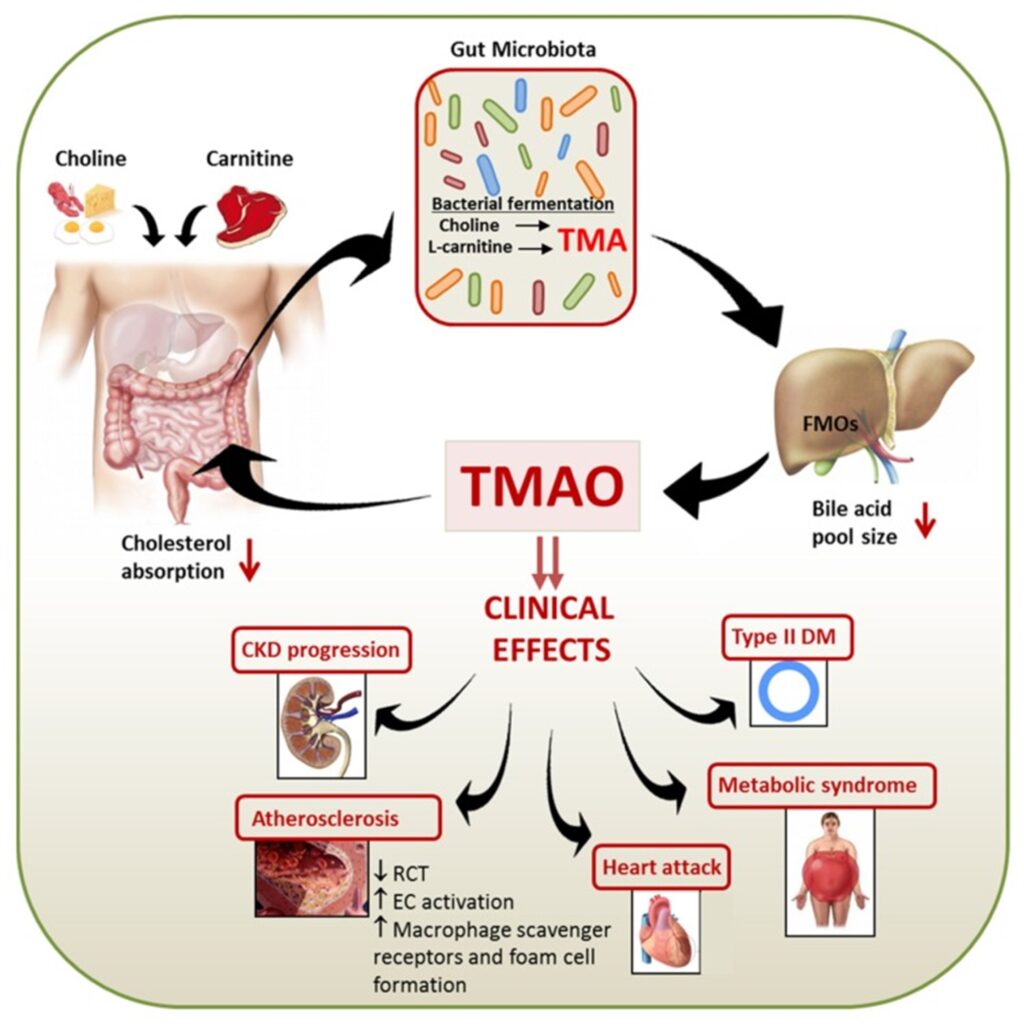Table of Contents
Trimethylamine N-oxide (TMAO) is a metabolite derived from dietary nutrients processed by gut bacteria. Emerging research links high TMAO levels to an increased risk of cardiovascular diseases, including heart attacks and strokes. It is essential to understand TMAO production, its impact on cholesterol metabolism, and its broader health implications for disease prevention and treatment.
What is TMAO?
TMAO is an amine oxide with a molecular mass of 75.1 daltons. It is naturally present in marine species, where it helps regulate environmental stress factors like temperature and pressure. However, in humans, TMAO plays a critical role in lipid metabolism and cardiovascular health, making it a subject of growing medical interest.
How is TMAO produced?
Gut microbiota generates trimethylamine (TMA) from various dietary sources, and TMAO is further synthesized from TMA.
- Choline (found in eggs, dairy, and red meat)
- Phosphatidylcholine (lecithin) (abundant in soy and meat products)
- L-carnitine (present in red meat and certain dairy products)
The liver converts TMA into TMAO through flavin-containing monooxygenases (FMO1 and FMO3). This metabolic process involves flavin monooxygenase (FMO3), which converts TMA into TMAO. Individuals with FMO3 mutations excrete excess TMA, leading to a fishy odor condition known as trimethylaminuria. Though, the human body excretes TMAO through the kidneys, high levels of TMAO in the bloodstream increases cardiovascular risks.
TMAO and Cardiovascular Health
1. The Gut-Heart Connection
Studies show that high TMAO levels correlate with increased cardiovascular risk, as TMAO influences cholesterol metabolism, inflammation, and arterial plaque formation.
2. TMAO’s Role in Cholesterol Metabolism
TMAO affects reverse cholesterol transport (RCT), the process of removing excess cholesterol from tissues. It also:
- Reduces enteral cholesterol transporter expression (Npc1L1)
- Impairs cholesterol clearance, leading to atherosclerosis (plaque buildup)
Functions of TMAO in the Body
Beyond cardiovascular health, TMAO serves multiple physiological roles:
- Protein Stabilization – Assists in protein folding and enzymatic function
- Osmoprotection – Regulates cell volume and prevents damage from high salt concentrations
- Gut Microbiome Regulation – Reflects microbiome diversity and function
- Metabolic Control – Impacts lipid and glucose metabolism
- Brain Function – Can cross the blood-brain barrier, suggesting a role in neurological health
TMAO and Diet: Which Foods Increase TMAO Levels?
Diets rich in choline, lecithin, and L-carnitine contribute to higher TMAO levels. Key sources include: ✔ Red meat (beef, lamb, pork) ✔ Egg yolks ✔ High-fat dairy products ✔ Saltwater fish
How to Lower TMAO Levels Naturally
❌ Reduce red meat and egg consumption ✅ Eat more plant-based foods rich in fiber ✅ Incorporate probiotics and prebiotics to support gut health ✅ Exercise regularly to enhance metabolic function

Clinical Testing: How is TMAO Measured?
A TMAO blood test can assess cardiovascular risk and gut microbiota function. Key testing guidelines include:
- Specimen Required: Freshly drawn serum (red-top tube) or EDTA plasma
- Fasting Requirement: 10-12 hours prior to blood collection
- Avoid Seafood: Fish and seafood can temporarily raise TMAO levels
TMAO Risk Levels:
- Low Risk: <6.2 µM
- Moderate Risk: 6.2 – 9.9 µM
- High Risk: ≥10.0 µM
Conclusion
TMAO is a crucial biomarker in heart disease prevention and metabolic health. While essential in marine biology, its role in human cholesterol metabolism and cardiovascular risk makes it a topic of growing interest.
By modifying diet, supporting gut health, and monitoring TMAO levels, individuals can potentially reduce their risk of heart disease and stroke.
References:
- Velasquez MT, Ramezani A, Manal A, Raj DS. Trimethylamine N-Oxide: The Good, the Bad and the Unknown. Toxins (Basel). 2016;8(11):326. Published 2016 Nov 8. doi:10.3390/toxins8110326
- Yang S, Li X, Yang F, Zhao R, Pan X, Liang J, Tian L, Li X, Liu L, Xing Y, Wu M. Gut Microbiota-Dependent Marker TMAO in Promoting Cardiovascular Disease: Inflammation Mechanism, Clinical Prognostic, and Potential as a Therapeutic Target. Front Pharmacol. 2019 Nov 19;10:1360. doi: 10.3389/fphar.2019.01360. PMID: 31803054; PMCID: PMC6877687.
- LabCorp Web assets

Very informative and helpful